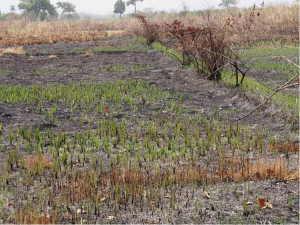A previously unattainable version of the sunflower genome has been released by a team of scientists from NRGene. The NRGene-produced genome is more comprehensive than any existing version. The assembled genome is 3.22 Gbp, built of scaffolds with an N50 of ~13.5 Mbp, less than 1% unfilled gaps, and the BUSCO results of 91% indicate that the genome is 90% complete.
Ugandan scientists are positive that GM potatoes will be commercially available in their country in 2020. According to Dr. Alex Barekye, Director of Kachwekano Zonal Agriculture Research Institute, research on disease resistant potato is underway. So far, three trials of Victoria potato variety have been conducted and the performance of the GM crop is good. No diseases were detected and the yield is high.
Miller and Kleidon (1) study future global deployment of wind turbines. They use a general circulation model (GCM) with 2.8° resolution to simulate the electricity generation for different wind-power deployments using global constant installed capacity densities. Results from the simulations with the maximum electricity generation over land and over water form the foundation for their study: a generation over 100 times greater than the global electricity demand (2).
In Vietnam, it is crucial that rice producers and traders learn more about effective rice storage techniques to preserve rice quality and increase its market value. One significant challenge among Vietnam farmers is proper rice storage and management to maintain its prime condition. Mismanagement of storage can lead to rice loss due to birds, rodents, and other animals, as well as grain quality deterioration.
The raw cashew nut production in Vietnam only accounts for about 30% of the total demand for export processing. So the way to improve productivity, output and processing between Vietnam and some African countries is very feasible. At the meeting of the African Union for the African Union (ACA) held in Benin, Le Quy Kha, Deputy Director of the Institute of Agricultural Science of the South, said at the conference.
It is the harmattan season when dry, dust-laden winds from the Sahara Desert sweep across West Africa. “As you can see, we had almost no rainfall here,” said Kouakou Ali, a technical assistant at the Africa Rice Center (AfricaRice), pointing to a landscape of devastation caused by bushfires, near the rice fields in M’bé in Côte d’Ivoire. In 2016, Côte d’Ivoire experienced the worst harmattan in three decades.
The Office of the Gene Technology Regulator (OGTR) has received a license application under the Gene Technology Act 2000 (the Act) for Dealings involving the Intentional Release (DIR) of genetically modified organisms (GMOs) into the Australian environment. The application (DIR 158) from GO Resources Pty Ltd proposes the commercial release of two lines of genetically modified (GM) safflower.
The Information Technology and Innovation Foundation (ITIF), one of the world's top science and technology body, together with a group of independent scientists, have submitted a letter to U.S. Interior Secretary Ryan Zinke to call on the department to reverse a Fish and Wildlife Service policy that phased out the use of genetically modified (GM) seeds. The letter argues that the policy was improperly adopted three years ago and stands at odds with the conservation objectives of the Fish and Wildlife Service.
The 2017 Global Hunger Index (GHI) indicates long-term advancement in decreasing global hunger. However, the progress has been uneven, with millions continuing to experience chronic hunger and many areas encountering food shortage and even starvation.
Rice is the most widely consumed staple food in India and a large part of the world's human population, especially in Asia. In this review we discussed about the Morphological and molecular mechanisms for drought tolerance in rice. Rice requires high temperature above 200C but not more than 35 to 400C. The lots of work have been done in this area to find out the cultivars, resistance to drought. Production of rice is decreasing day by day due to many biotic and abiotic stresses.


 Curently online :
Curently online :
 Total visitors :
Total visitors :









